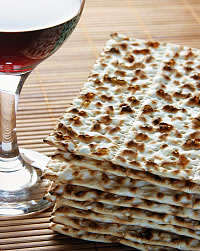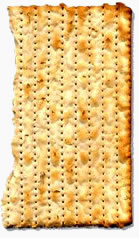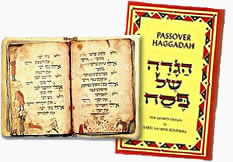Passover – the meal
Jesus said: “I have eagerly desired to eat this Passover with you before I suffer. I will not eat it again until it finds fulfillment in the Kingdom of God.”
~ Luke 22:15-16
Jesus was a Jew and Jews were required, under the Law of Moses, to celebrate the Passover every year, to remember the Exodus from Egypt. The Last Supper, when Jesus ate with His disciples, was a Passover meal. Many elements in the ritual of the Passover meal pointed to the sacrifice that would be made by the expected Messiah who would rescue Israel not from slavery in Egypt but from slavery to sin. Jesus was the Messiah of Israel, and Jesus is the Saviour of all who believe in Him.
From the time of Moses, Jews have celebrated the Passover in the same way. The celebration is called a ‘seder’. It means ‘order’ in Hebrew. There is a set order of service that has varied little for more than 3,500 years.
The sequence can be summarised as follows:
From the time of Moses, Jews have celebrated the Passover in the same way.
- A blessing is said over the first of four cups of wine.
- The host washes his hands.
- The middle one of three matzah – that is, unleavened bread – is broken in two. One of the broken halves is hidden until after the meal.
- The Passover story is told.
- A second cup of wine.
- Everyone washes their hands.
- Bitter herbs are eaten. In Exodus 12:8 the Jews were told to eat the lamb with unleavened bread and with bitter herbs. In Hebrew the bitter herbs are called ‘maror’. They are usually grated horseradish.
- The main meal. The main course is roasted lamb.
- A blessing is said after the meal.
- The broken half of matzah, which had been hidden, is brought back to the table. It has to be found by a child. The matzah is broken into pieces and distributed. Everyone eats of the bread.
- A third cup of wine.
- A child opens the door to see if Elijah is there. The Bible says that Elijah would come and precede the Messiah.
- Psalms 113 to 118 – the ‘hallel’, the praise psalms – are sung.
- A fourth cup of wine.
Note that four cups of wine are drunk.
In Exodus, God said through Moses:
The four cups of wine represent four promises made to Israel:
- The first cup of wine is called the cup of sanctification
It is to commemorate the promise: “I will bring you out.”
- The second cup is called the cup of plagues
It reflects the plagues that came upon Egypt – and it relates to the second promise: “I will free you from being slaves.”
- The third cup is called the cup of redemption
God says: “I will redeem you.”
- The fourth cup is called the cup of completion
God says: “I will take you as my own people.”
There are four cups of wine in the Passover meal to remind the Israelites of those four promises. The New Testament account of the Last Supper draws attention to two of those cups, and omits the last. This is significant. In addition, we see the following in the actions of Jesus.

The seder starts with the first cup of wine – the cup of sanctification: “I will bring you out”. God brings us out of Egypt – out of the world and out of spiritual slavery to sin and the fear of death. Jesus drank this cup of wine with the disciples [Luke 22:17].
Either at the point where the host washes His hands, or when everyone washes their hands, Jesus washed the feet of His disciples [John 13:3-5,12-17].
John 13:3-5,12-17
Jesus knew that the Father had put all things under His power and that He had come from God and was returning to God; so He got up from the meal, took off His outer clothing and wrapped a towel around His waist. After that, He poured water into a basin and began to wash His disciples’ feet, drying them with the towel that was wrapped around Him.
When He had finished washing their feet He put on His clothes and returned to His place. “Do you understand what I have done for you?” He asked them. “You call Me ‘Teacher’ and ‘Lord,’ and rightly so, for that is what I am. Now that I, your Lord and Teacher, have washed your feet, you also should wash one another’s feet. I have set you an example that you should do as I have done for you. I tell you the truth, no servant is greater than his master, nor is a messenger greater than the one who sent him. Now that you know these things, you will be blessed if you do them.”
×The three matzot – the unleavened bread – remind us of the Trinity – the Father, the Son and the Holy Spirit. Significantly, in the seder, the middle matzah is taken out and broken in two. Jesus’ body was ‘broken’ for us.
Half is eaten then and half is hidden until later. Understanding God’s promise of salvation for the remnant of Israel, we see a picture of the harvest of Jews who first came to faith and those who will find salvation in a time to come. The broken half is hidden during the seder and has to be found, later, by a child.
Jesus had said:

Childlike faith and trust is the way to God.
Note the appearance of the matzah. It is easy to see what looks like bruises and stripes, and that it is pierced. Isaiah prophesied about the Messiah:
He was pierced for our transgressions, He was bruised for our iniquities; the punishment that brought us peace was upon Him, and by His stripes we are healed.”
[Isaiah 53:5]
Unleavened bread is bread without yeast. Yeast makes dough puff up. The matzah is also pierced – again, to stop it puffing up. Jesus was meek and mild – the opposite of proud and arrogant.
The second cup of wine is not mentioned in the gospels. It is the cup of plagues, drunk after the Passover story is told but before the meal.
At the point where bitter herbs are eaten, Jesus revealed that He would be betrayed by Judas: “The one who has dipped his hand into the bowl with Me will betray Me” [Matthew 26:20-25].
Matthew 26:20-25
When evening came Jesus was reclining at the table with the Twelve. And while they were eating He said, “I tell you the truth, one of you will betray Me.”
They were very sad and began to say to Him one after the other, “Surely not I, Lord!”
Jesus replied, “The one who has dipped his hand into the bowl with Me will betray Me. The Son of Man will go just as it is written about Him. But woe to that man who betrays the Son of Man! It would be better for him if he had not been born.”
Then Judas, the one who would betray Him, said, “Surely not I, Rabbi?” Jesus answered, “Yes, it is you.”
×When the half matzah is found it is broken into pieces, distributed and eaten by everyone. Jesus said, at this point: “Take and eat; this is My body” [Matthew 26:26].
Matthew 26:26
While they were eating, Jesus took bread, gave thanks and broke it, and gave it to His disciples, saying, “Take and eat; this is My body.”
×The third cup of wine is the cup of redemption. This is where Jesus announced the New Covenant for the forgiveness of sins [Luke 22:20, Matthew 26:27-28]. He did not drink the fourth cup of wine – the cup of completion. He said that He will drink that cup with us in heaven [Matthew 26:29] at the marriage supper of the Lamb.
Luke 22:20
In the same way, after the supper He took the cup, saying “This cup is the New Covenant in My blood which is poured out for you.”
Matthew 26:27-28
Then He took the cup, gave thanks and offered it to them, saying, “Drink from it, all of you. This is My blood of the Covenant which is poured out for many for the forgiveness of sins.”
×Matthew 26:29
“I tell you, I will not drink of this fruit of the vine from now on until that day when I drink it anew with you in My Father’s Kingdom.”
×They sang the hallel (or praise) psalms ending with Psalm 118 [Matthew 26:30].
Psalm 118 is one of the great Messianic passages in the Old Testament. It contains the following prophetic verses:
When Jesus made His triumphal entry into Jerusalem, at the start of the passion week, the crowds cried out:
This, together with their cry of “Hosanna to the Son of David!” was acknowledgement of the Messiah. The terms in the Tanach were accepted as Messianic.
Jesus had said to the teachers of the Law and Pharisees: “You will not see Me again until you say, ‘Blessed is He who comes in the name of the Lord’” [Matthew 23:37-39].
Matthew 23:37-39
“O Jerusalem, Jerusalem, you who kill the prophets and stone those sent to you, how often I have longed to gather your children together, as a hen gathers her chicks under her wings, but you were not willing. Look, your house is left to you desolate. For I tell you, you will not see Me again until you say, ‘Blessed is He who comes in the name of the Lord.’”
×Jews who have rejected Jesus are waiting for the Messiah to come. He has come. And He is coming again. They will say:
“Baruch ha’ba b’shem Adonai”
“Blessed is He who comes in the name of the Lord”
Related messages


